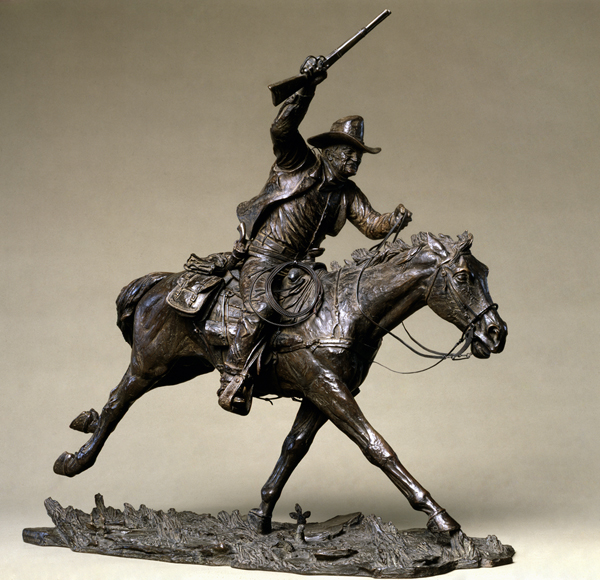Harry Jackson: born April 13, 1924.
Mr. Jackson, infatuated by the West from early childhood, headed to Wyoming from his hometown, Chicago, at 14 and found work as a ranch hand, working his way up to cowboy. There, when not tending cattle, he turned out shoot-’em-up sketches in the manner of Frederic Remington.
After enlisting in the Marine Corps at 18, he was assigned as a sketch artist to the Fifth Amphibious Corps. He was seriously wounded in the battle for Betio Island in the Tarawa atoll in November 1943 and again at Saipan, for which he was awarded the Purple Heart. Because of his war injuries, he struggled throughout his life with life-threatening epileptic seizures and severe mood disorders.
After being shipped to Los Angeles, he was made an official Marine Corps combat artist, with the assignment to execute drawings and paintings depicting, as he put it, “my bloodiest close-combat experiences.” This he did in paintings like Tarawa-Betio (1944), now in the collection of the National Museum of the Marine Corps in Triangle,
After seeing the Jackson Pollock painting The Moon-Woman Cuts the Circle, Mr. Jackson underwent an artistic conversion. The painting, he said, “shot the first crack of daylight into my blocked-off brain.” He moved to New York, where he became a close friend of Pollock’s and began painting in the Abstract Expressionist style.
He quickly gained notice as an artist to watch when Meyer Schapiro and Clement Greenberg included him in their “Talent 1950” exhibition at the Kootz Gallery, and over the next several years he exhibited at Tibor de Nagy, a nerve center of second-generation Abstract Expressionism.
After traveling to Italy in the early 1950s, he re-embraced realism and undertook a journey in reverse that Life magazine chronicled in an extensive 1956 photo essay, “Painter Striving to Find Himself: Harry Jackson Turns to the Hard Way.” One of his first and most ambitious works in the realist mode was The Italian Bar, a large-scale painting, which showed a gathering of regulars in the Mare Chiaro tavern on Mulberry Street in Little Italy.
Returning full circle to the subject matter that had captured his imaginaion as a boy, the West, he produced works such as The Stampede and The Range Burial,” sequential paintings depicting a frenzied herd of longhorn cattle dragging a young cowboy off his horse and the somber burial ceremony on the prairie.
He became good friends with John Wayne in the last decade of that actor’s life. In 1969, for the cover of Time magazine, he created The Marshal, a sculpture showing Wayne, as Rooster Cogburn in True Grit, on a galloping horse brandishing a rifle in his right hand.
In a review of Mr. Jackson’s cowboy art for The New York Times in 1980, Hilton Kramer called his career “unlike any other in the recent history of American art.” His change of direction, Mr. Kramer wrote, “has turned a well-known and highly praised but penurious young artist into one of the wealthiest ‘unknown’ artists in America — an artist unknown, that is, to the art world where his first reputation was made 30 years ago.”
Harry Aaron Shapiro Jr. was born on April 18, 1924, in Chicago. After his parents divorced, his mother, whose maiden name was Jackson, renamed him Harry Andrew Jackson. As a child Harry worked at his mother’s lunchroom in the Chicago stockyards and developed a fascination with the cowboys he met there. He took Saturday art classes at the Art Institute, and even after moving to Wyoming he returned to Chicago in the winter to resume his art education.
After rejecting Abstract Expressionism, he found his footing as a Western artist when he received a commission in 1958 to create two heroic-size paintings for the Whitney Gallery of Western Art in Cody. The resulting works, each 10 feet by 21 feet, were The Stampede and The Range Burial, which he later executed as bronzes and lithographs.
His other works include “Sacagawea,” a large outdoor sculpture at the Buffalo Bill Historical Center in Cody that honors that Shoshone woman who accompanied the Lewis and Clark expedition.
Mr. Jackson’s six marriages ended in divorce. In addition to his son Matthew, of Cody, he is survived by two other sons: Jesse, of Miami, and Luke, of Brooklyn; two daughters, Molly Keating of Brownsville, Vt., and Chloë Lear Jackson of Los Angeles; and four grandchildren.
Biography courtesy of AskART.com.
See it First!
Receive notifications from America's online art gallery when the latest works from top artists are available.



